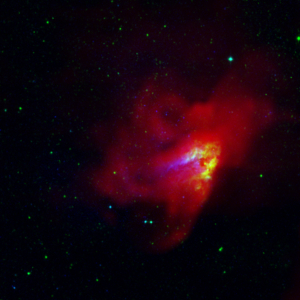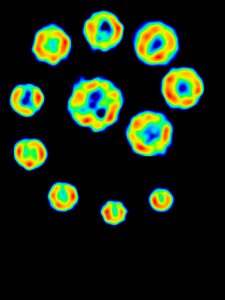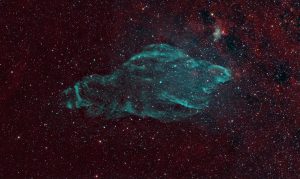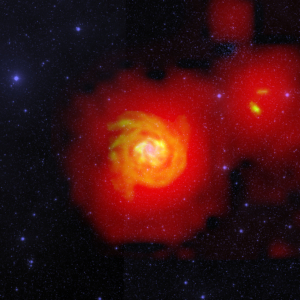A radio and infrared wave panorama of a section of the Milky Way in the constellations of Scutum and Aquila. Normal stars show up as the myriad of yellow-white points. Radiation from the newborn stars heats surrounding dust into infrared temperatures (in gold), while the ultraviolet light from these stars separates electrons from hydrogen atoms, and gives off radio waves (in red). More mature stars have destroyed nearby dust, leaving red cores surrounded by yellow, then gold, shells as the temperature drops far from the stars. Massive stars have died in titanic explosions and blasted their gas light years into space at thousands of miles per second, leaving blast arcs (in red). The diffuse infrared glow (gold) comes from the tiny dust particles scattered through space.


The Omega Nebula
The Omega Nebula (also known as M17, the Swan Nebula, and the Lobster Nebula) lies about 5700 light years away in the constellation of Sagittarius. The nebula is found at the edge of a dark gas cloud in which new stars are being born. Optical light, infrared radiation and radio waves are emitted by the nebula. The infrared radiation (green) is emitted by dust clouds warmed by new stars imbedded in the nebula. The optical light (blue) and radio waves (red) are produced when hot, young stars ionize the gas around them. While much of the optical light is blocked by foreground dust clouds, the radio radiation streams on through, allowing us to see all of the hot gas with the Green Bank Telescope (GBT).

The Expansion of Supernova 1993j
SN 1993J was discovered March 28, 1993, by Francisco Garcia Diaz, an amateur astronomer in Lugo, Spain, using a 10-inch Newtonian telescope. Located in M81, a spiral galaxy in the constellation Ursa Major, this supernova is 11 million light-years from Earth. By observing at regular intervals with the Very Long Baseline Array (VLBA), the Very large Array (VLA), and various tracking stations around the world, we have produced this sequence of images showing a shell-like radio structure that has expanded for seven years with circular symmetry. At first the expansion rate was nearly 10,000 miles per second, but it has decelerated since, and had slowed to less than 6,000 miles per second by February, 2000. In this false color image, blue is faintest and red brightest.

Stars Forming in our Galaxy’s Heart
The Galactic Center and the surrounding Central Molecular Zone make up the most active star formation region in the Milky Way. Regions of molecular hydrogen (purple), seen by the Very Large Array (VLA), are illuminated by hot, massive stars, supernova remnants, and synchrotron emission. The Caltech Submillimeter Observatory observed cold (20-30 K) dust associated with molecular gas (orange). Some of this material will form stars within in the next few million years; the remainder will be blown away. The diffuse cyan and colored star images are from the Spitzer Space Observatory’s Infrared Array Camera. The cyan is primarily emission from stars, the point sources, and from polycyclic aromatic hydrocarbons (PAHs), the diffuse component.

W50: The Manatee Nebula
This enormous W50 cloud, visible only in radio waves, formed when a giant star, 18,000 light years away in the constellation of Aquila, exploded around twenty thousand years ago. The remaining black hole feeds on gas it collects from a very close companion star. Its gas disk and powerful magnetic field lines act like an enormous railroad system. It snags charged particles and channels them outward as powerful jets traveling at nearly the speed of light. This system shines brightly in both radio waves and X-rays and is known collectively as the SS433 microquasar. Over time, the microquasar’s wobbling jets have punched corkscrew bulges on either side of W50, seen here in this image from the Very Large Array (VLA).

Rivers of Hydrogen Connect Clusters of Galaxies
This composite image contains three distinct features: the bright star-filled central region of galaxy NGC 6946 in optical light (blue), the dense hydrogen tracing out the galaxy’s sweeping spiral arms and galactic halo (orange), and the extremely diffuse and extended field of hydrogen engulfing NGC 6946 and its companions (red). The new GBT data show the faintly glowing hydrogen bridging the gulf between the larger galaxy and its smaller companions. This faint structure is precisely what astronomers expect to appear as hydrogen flows from the intergalactic medium into galaxies or from a past encounter between galaxies.





